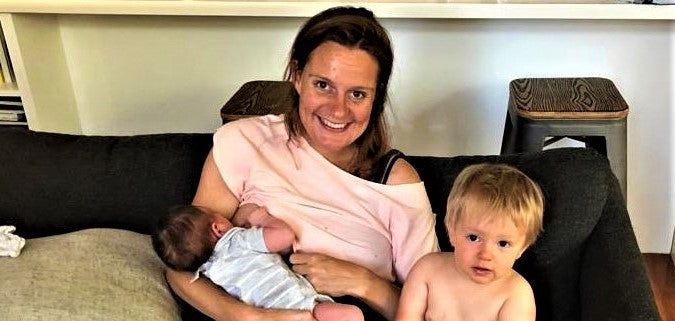In this article discover how to collect colostrum prior to giving birth and how it can help you and your baby.

What is antenatal expressing and discover how to collection colostrum with Libby Morgan, Endorsed Midwife, Registered Nurse, IBCLC Lactation Consultant, Child & Family Health Nurse.
Our breasts do some pretty incredible things, even before we give birth. In fact, you might have come across the term ‘antenatal expressing’, and might be wondering what it’s all about.
No matter what your feeding journey ends up looking like, getting to know your breasts better before bub arrives is a great way to help you feel more comfortable and confident if you do decide to breastfeed.
To find out more about antenatal expressing, we chatted with Libby Morgan (an Endorsed Midwife, Registered Nurse, IBCLC Lactation Consultant, Child & Family Health Nurse AND a mother of FIVE!) from MILC - Mothers Infants and Lactation Consultancy.
Keep reading to discover what antenatal expressing is, the power of colostrum, and how breast massage can help you when expressing before birth.
What is antenatal expressing?
It might sound complicated, but antenatal expressing simply means using our hands to express colostrum before bub is born. Usually, mamas are encouraged to try antenatal expressing towards the end of their pregnancy (from 36 weeks) however, this should always be discussed with your care provider prior to commencing.
Our breasts start to produce colostrum (a thick, highly concentrated liquid packed with protein and nutrients) from our 16th to 20th week of pregnancy. Because colostrum is filled with a lot of beneficial nutrients, it can be helpful to try expressing and storing it in the freezer prior to birth.
Libby discussed with us that the concept of antenatal expressing initially focussed on decreasing the chance of newborns receiving supplemental formula due to dropping blood sugar levels. A 2017 trial that looked at whether expressing before birth for women with diabetes is safe found that having some colostrum frozen and stored prior to birth was safe for women with diabetes and low risk pregnancies and found that their babies were less likely to receive supplemental formula in the first 24hrs after birth. Now, the practice has become more mainstream with many women expressing and having colostrum on hand for their babies for a variety of reasons.
Libby pointed out that we shouldn't expect to produce much colostrum, especially when we first start with antenatal expressing.
The Australian Breastfeeding Association notes that in the 2017 trial the median amount of colostrum mothers expressed was 5ml in total.
“I see a lot of mums get really disheartened that it’s only a few, tiny drops,” tells Libby. “But the truth is you might only get a little glisten on your nipple to start with and that’s totally okay. I very rarely see women expressing big quantities straight away, and we’re really only trying to gather small amounts of colostrum.”
What are the benefits of collecting colostrum?
All of us are going to have a totally different experience with breastfeeding, and that’s to be expected! Whilst collecting colostrum might suit some (with some describing it as having “the most positive influence on my first days as a mother”), it doesn't suit everyone. Whether it is right for you or not, Libby shares that there are some helpful benefits of antenatal expressing, such as:
-
It helps you get to know your breasts: by becoming familiar with your breasts and how they work during pregnancy, you’ll start to develop the skills and confidence that can help you during breastfeeding (if that’s the approach you feel is right for your body). Plus knowing how to hand express is always beneficial.
-
It gives you an extra source of food for bub: if your bub experiences low sugar levels, has latching difficulties or is extra sleepy, having colostrum stored away is great if your baby requires additional feeds. Plus, if you ever get separated from bub, it’s helpful to have some colostrum ready to go. But if antenatal expressing doesn’t work for you, don’t worry! There’s always other ways to supplement your baby’s diet.
- It can help you give your sore breasts a break if you need it: breastfeeding can take a toll on your breasts, especially if you’re trying to feed every couple of hours during those first few days. That’s why it can be helpful to have colostrum on hand, so if your breasts are tired or sore then you can give them a little rest.
How to collect colostrum
Libby’s top tips on how to collect colostrum: Just like breastfeeding, antenatal expressing might happen straight away (or feel totally impossible!). No matter what experience you have, remember you know your body better than anyone else, so do what feels right for you.
But if you did want some extra pointers when trying antenatal expressing, here’s a few ideas from Libby:
- Use heated breast massage to encourage your colostrum flow: Libby recommends mamas try using a heated Lactamo or even use Lactamo in the shower to gently massage your breasts and encourage blood flow and the release of colostrum.
- Use a gentle but firm amount of pressure: Libby explains to place your thumb and forefinger around the areola. Gently push back towards your chest and roll your thumb and fingers together (compress). Move around the areola to express all the milk ducts. It should not be painful but often it will be slightly uncomfortable.
- Practice makes perfect: the motion of hand expressing takes a bit of practice, and involves squeezing and rolling your fingers forward. But don’t put too much pressure on yourself to get it right the first time! Keep at it and ask for support from your lactation consultant if you’re feeling overwhelmed - you don’t have to go it alone, mama.
- Sometimes antenatal expressing may not be recommended, especially if you are at risk, (for example have had threatened premature labour, have a cervical suture, have experienced bleeding during your pregnancy or you have been diagnosed with placenta previa). Always speak to your maternity care provider first.
Ultimately, antenatal expressing isn’t going to be right for everyone. While it can be a helpful way to get to know your breasts before birth, don’t worry if it doesn’t work out for you. All of us will have a totally different feeding experience. And we think you’re doing great already, mama.
If you’re looking for extra support on your breast massage journey, our Lactamo ball can help you navigate common breastfeeding problems (such as block ducts and engorgement) and is heatable, coolable and reusable. Find out more about our Lactamo massage ball.
If in doubt, please always consult your healthcare professional.






